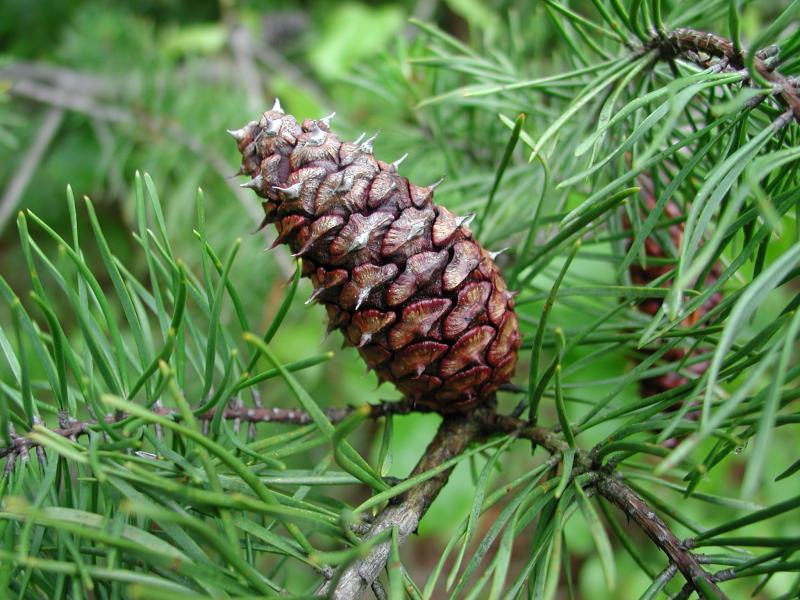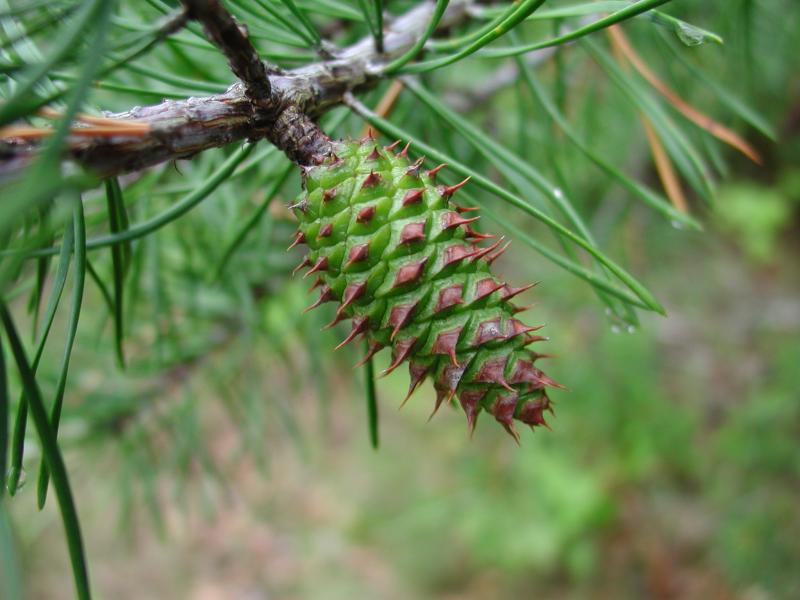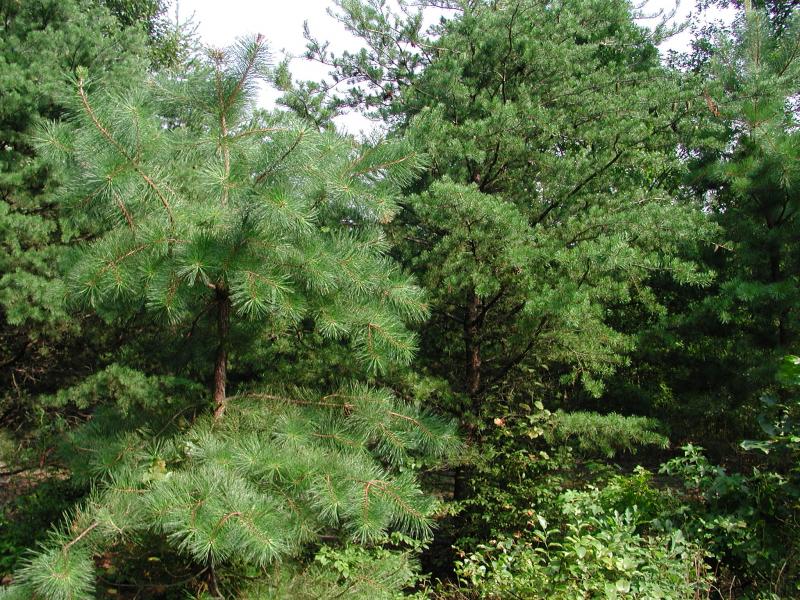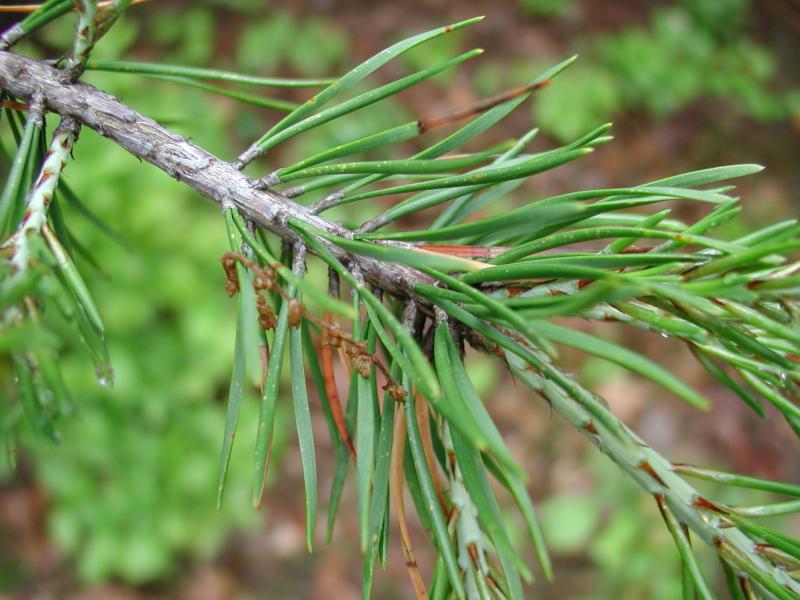Virginia Pine
Pinus virginiana P. Mill.
- Class
- Pinopsida (Conifers)
- Family
- Pinaceae (Pine Family)
- State Protection
- Endangered
Listed as Endangered by New York State: in imminent danger of extirpation in New York. For animals, taking, importation, transportation, or possession is prohibited, except under license or permit. For plants, removal or damage without the consent of the landowner is prohibited.
- Federal Protection
- Not Listed
- State Conservation Status Rank
- S1
Critically Imperiled in New York - Especially vulnerable to disappearing from New York due to extreme rarity or other factors; typically 5 or fewer populations or locations in New York, very few individuals, very restricted range, very few remaining acres (or miles of stream), and/or very steep declines.
- Global Conservation Status Rank
- G5
Secure globally - Common in the world; widespread and abundant (but may be rare in some parts of its range).
Summary
Did you know?
Virginia pine has been used to reclaim abandoned lands and strip-mine sites because it survives well in poor soils and is resistant to pests (Pinus virginiana in USDA Forest Service fact sheets, accessed 16 November 2007). It is at its northern limit on Staten Island and the Hudson Highlands.
State Ranking Justification
There are four existing populations but all of them are very small and under some threat from the surrounding vegetation. There are about five or six historical records but some of these may be the same occurrence as existing populations and others are from areas that are highly developed with little chance that they still exist.
Short-term Trends
The remaining populations seem stable although they may decline in the future without proper management.
Long-term Trends
This species was never common in New York and there were probably only four or five populations that ever existed at one time.
Conservation and Management
Threats
These small populations are threatened by the succession of surrounding vegetation and vines.
Conservation Strategies and Management Practices
Its habitat should be cleared of encroaching trees and vines and populations should be expanded by natural generation or human propagation.
Research Needs
It should be determined if populations can be expanded by propagation of seed and planting of seedlings.
Habitat
Habitat
In New York, as elsewhere, this tree is associated with habitats of low productivity due to poor, dry soils. It has been found at openings within coastal oak forests, barrens of pitch pine and/or of scrub oak, and open, rocky summits (New York Natural Heritage Program 2007). Barrens and sterile soil (Fernald 1970). Dry, sandy or sterile soil (Gleason & Cronquist 1991).
Associated Ecological Communities
- Coastal oak-beech forest*
(guide)
A hardwood forest with oaks and American beech codominant that occurs in dry well-drained, loamy sand of morainal coves of the Atlantic Coastal Plain. Some occurrences are associated with maritime beech forest.
- Coastal oak-heath forest*
(guide)
A low diversity, large patch to matrix, hardwood forest that typically occurs on dry, well-drained, sandy soils of glacial outwash plains or moraines of the Atlantic Coastal Plain. The forest is usually codominated by two or more species of scarlet oak, white oak, and black oak.
- Pitch pine-oak-heath rocky summit
(guide)
A community that occurs on warm, dry, rocky ridgetops and summits where the bedrock is non-calcareous (such as quartzite, sandstone, or schist), and the soils are more or less acidic. This community is broadly defined and includes examples that may lack pines and are dominated by scrub oak and/or heath shrubs apparently related to fire regime.
* probable association but not confirmed.
Associated Species
- Acer rubrum
- Betula populifolia (gray birch)
- Castanea dentata (American chestnut)
- Eupatorium hyssopifolium var. laciniatum
- Fagus grandifolia (American beech)
- Hypericum hypericoides multicaule
- Liquidambar styraciflua (sweet-gum)
- Nyssa sylvatica (black-gum, sour-gum)
- Panicum virgatum (switch grass)
- Populus grandidentata (big-toothed aspen)
- Quercus bicolor (swamp white oak)
- Quercus palustris (pin oak)
- Quercus rubra (northern red oak)
- Quercus stellata (post oak)
- Quercus velutina (black oak)
- Rhexia virginica (Virginia meadow-beauty)
- Sassafras albidum (sassafras)
- Schizachyrium scoparium
- Smilax rotundifolia (common greenbrier)
- Solidago speciosa (showy goldenrod)
- Vaccinium corymbosum (highbush blueberry)
Range
New York State Distribution
In New York Virgininia Pine has been collected from Long Island, New York City, and the Hudson Highlands as far north as Orange County.
Global Distribution
Virginia Pine's range roughly coincides with the central and southern Appalachian Mountains and adjacent areas, extending from southern New York to northern Georgia and Alabama, and in the Ohio Valley to parts of Tennessee, Kentucky, Indiana, and Ohio.
Identification Comments
General Description
Virginia Pine is a small or medium sized tree (to about 20 m tall), the trunk usually with spreading branches and somewhat contorted. The bark has dark brown to grayish, irregular and loose scales, and shallow fissures. The needles are short (2-8 cm) and in bundles of 2. The seed-bearing cones are slender and curved when closed, becoming egg-shaped and 3-7 cm long, when open. Each scale of the cone has a sharp prickle 2-3mm long. They may persist on the trees for several years after ripening.
Similar Species
Jack Pine (Pinus banksiana) is normally even smaller and more contorted than Virginia Pine, has even shorter (2-4 cm) needles, and its cones are smaller with no prickle (or only a tiny, weak one).
Shortleaf Pine (Pinus echinata) is normally a taller, thicker, straighter tree. It has needles which are bundled into groups of both 2's or 3's, and which are generally longer (7-11 cm) than those of Virginia Pine. Its cones are without a prickle or only weakly prickled.
Best Time to See
The trees and their persistent cones are visible and identifiable any time of year.
- Vegetative
- Fruiting
The time of year you would expect to find Virginia Pine vegetative and fruiting in New York.
Virginia Pine Images
Taxonomy
Virginia Pine
Pinus virginiana P. Mill.
- Kingdom Plantae
- Phylum Coniferophyta
- Class Pinopsida
(Conifers)
- Order Pinales
- Family Pinaceae (Pine Family)
- Order Pinales
- Class Pinopsida
(Conifers)
- Phylum Coniferophyta
Additional Common Names
- New Jersey Pine
- Scrub Pine
Additional Resources
Best Identification Reference
Flora of North America Editorial Committee. 1993. Flora of North America, North of Mexico. Volume 2. Pteridophytes and Gymnosperms. Oxford University Press, New York. 475 pp.
Other References
Fernald, M.L. 1950. Gray's manual of botany. 8th edition. D. Van Nostrand, New York. 1632 pp.
Gleason, Henry A. and A. Cronquist. 1991. Manual of Vascular Plants of Northeastern United States and Adjacent Canada. The New York Botanical Garden, Bronx, New York. 910 pp.
Holmgren, Noel. 1998. The Illustrated Companion to Gleason and Cronquist's Manual. Illustrations of the Vascular Plants of Northeastern United States and Adjacent Canada. The New York Botanical Garden, Bronx, New York.
New York Natural Heritage Program. 2010. Biotics database. New York Natural Heritage Program. New York State Department of Environmental Conservation. Albany, NY.
New York Natural Heritage Program. 2024. New York Natural Heritage Program Databases. Albany, NY.
Rhoads, Ann F. and Timothy A. Block. 2005. Trees of Pennsylvania. A Complete Reference Guide. University of Pennsylvania Press, Philadelphia, PA.
Weldy, T. and D. Werier. 2010. New York flora atlas. [S.M. Landry, K.N. Campbell, and L.D. Mabe (original application development), Florida Center for Community Design and Research http://www.fccdr.usf.edu/. University of South Florida http://www.usf.edu/]. New York Flora Association http://newyork.plantatlas.usf.edu/, Albany, New York
Weldy, Troy W. and David Werier. 2005. New York Flora Atlas. [S.M. Landry, K.N. Campbell, and L.D. Mabe (original application development), Florida Center for Community Design and Research. University of South Florida]. New York Flora Association, Albany, NY. Available on the web at (http://newyork.plantatlas.usf.edu/).
Links
About This Guide
Information for this guide was last updated on: January 18, 2008
Please cite this page as:
New York Natural Heritage Program. 2024.
Online Conservation Guide for
Pinus virginiana.
Available from: https://guides.nynhp.org/virginia-pine/.
Accessed July 27, 2024.



